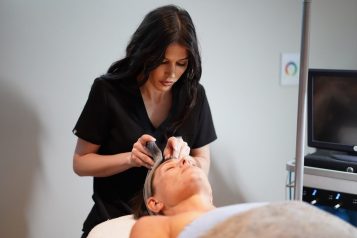
As we age, change is inevitable – especially when it comes to our skin and the challenges each of us faces. Now in their 30s and early 40s, millions of millennials are suddenly experiencing their next big skin challenge: dark spots. What many don’t realize is these dark spots could very well be a clinical skin condition called melasma and your local dermatologist can help.
Although less well-known by its clinical name than many other skin conditions, melasma is a pigmentation disorder of the skin that primarily impacts women. Melasma often appears as dark spots seen as brown or gray patches on the bridge of the nose, cheeks, forehead, upper lip, or chin. Aside from appearing on the face, melasma is also sometimes found on the forearms, neck, and shoulders. Research shows the prominent location of these spots – and their severity – can lead to significant challenges in self-esteem and quality of life for patients. More so than any generation before, millennials are actively seeking to reverse the appearance of melasma, and they are spending higher amounts on out-of-pocket cosmetic procedures and prescriptions to achieve their desired results.
While procedures such as chemical peels and laser therapies are being used, hydroquinone is one of the most prescribed and popular treatments for patients. This topical treatment allows for precise treatment of affected skin, without the higher costs and longer recovery times of surgical services.
Unfortunately, not all forms of hydroquinone are created equally. In 2022 the FDA issued warning letters to 12 companies for selling hydroquinone over-the-counter (OTC) without a prescription. The FDA also alerted consumers there are no FDA-approved or otherwise legally marketed OTC skin-lightening products containing hydroquinone. This places a serious question mark over many of today’s providers of hydroquinone.
In fact, the FDA’s notification sent shockwaves across the health and beauty industry as it essentially limited access to hydroquinone to two prescription choices: Tri-Luma from Galderma Laboratories; or customized medicines including those made by 503B FDA-registered outsourcing facilities that include hydroquinone in their unique formulations. A leading example of the latter is SKNV, which makes customized prescription medications for dermatologists – including 21 containing hydroquinone as an active ingredient. With either choice, your local dermatologist remains the best source for diagnosing and determining the right treatment for your melasma.
According to the Cleveland Clinic, pregnant women are almost twice as likely to develop melasma compared to the general population. Other leading causes of melasma are sun exposure, age, hormones (including birth control pills), and even negative reactions to particular skin care products or other medications. With millennials waiting longer to have children, the combination of all these factors has created the perfect storm for melasma to emerge as the leading skin condition concern for this generation.
Dealing with melasma can be frustrating but most people agree we often feel our best when we look our best. Luckily, millennials tend to be more regimented when it comes to beauty and skincare than generations past. They are more likely to apply moisturizers, spot treatments, SPF, and exfoliators.
For variables within one’s control, strict sun protection is among the most important practices when preventing or treating melasma. Ultraviolet rays can trigger the overproduction of melanin levels in the skin, which is more likely to trigger or aggregate dark spots on exposed areas of the skin.
It’s important to consult a dermatologist for a correct diagnosis. Some people may experience melasma for their entire lives, while others have it for a short period of time, such as during pregnancy. Though it is not painful, melasma can cause mental distress, so finding the proper treatment is important for each individual.
Millennials have proven time and again that they are ingenious and often relentless when facing problems others choose to live with or simply ignore. Melasma will be no different, and the good news is several solutions and treatment plans are readily available.
All U.S. dermatologists have access to SKNV-customized medications via their EMR, and the full list of SKNV medications for prescribing is available at www.sknvmatch.com.
Written in partnership with Ascend.
For more information, visit Dr. Brian A. Levine's social media:

























